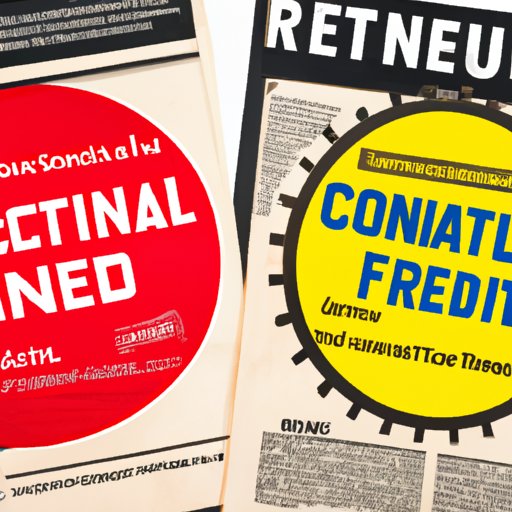
Introduction
Money makes the world go round. It is essential for our daily lives, whether we are purchasing groceries or paying rent. But have you ever wondered where money comes from? More specifically, how is it created?
Money creation is a complex process that is still shrouded in mystery for many people. In this article, we will explore how banks create money out of thin air and the impact this has on our lives and the economy as a whole.
Importance of Understanding Money Creation
Understanding how money is created is essential for everyone. It helps us to make informed decisions about our finances and the impact that financial decisions have on the broader economy.
Money creation is a process that affects us all, yet it is not widely understood. By gaining insight into the practice, we can make informed decisions about our spending habits, investments, and savings.
Exploring the Mysterious Process of Money Creation: How Banks Create Money Out of Thin Air
Definition of Money Creation
Money creation is the process by which new money is brought into circulation. The money supply is increased when banks create new money by making loans.
As consumers repay loans, money is taken out of circulation, and the money supply decreases. Money creation is an ongoing process that impacts the economy at all levels.
Role of Banks in Money Creation
Banks play a critical role in creating money. When a bank makes a loan, it creates new money in the form of a balance in the borrower’s account. The bank does not need to have physical cash on hand to make a loan and increase the money supply.
This ability to create money out of thin air is a significant power held by banks. While it can fuel economic growth, it can also lead to financial instability if not carefully regulated.
Fractional Reserve Banking
The process of money creation is made possible by fractional reserve banking. This system allows banks to hold a fraction of the money deposited into their accounts and lend out the rest, creating new money in the process.
For example, if a bank has a reserve requirement of 10%, they must hold 10% of all deposits in reserve and can lend out 90%. As new loans are made and money is created, the reserve requirement remains the same, allowing the bank to create even more money in the future.
Money Creation 101: The Basics of How Money is Created by Financial Institutions and Why It Matters
Creating Money Through Loans
Banks create money by making loans to individuals and businesses. When a loan is approved, the bank creates new money by adding the amount of the loan to the borrower’s account. This new money can then be spent by the borrower, increasing the overall money supply.
The bank’s ability to create new money through loans is why the banking sector plays such a crucial role in the economy. It fuels economic growth by providing businesses and individuals with the capital they need to invest and spend.
Impact of Money Creation on the Economy
The impact of money creation on the economy can be significant. When there is a surge in lending and new money creation, it can lead to economic expansion. However, if too much money is created too quickly, it can lead to inflation.
On the other hand, limiting the amount of money that can be created can restrict economic growth and result in a recession. It is a delicate balance that requires careful control and management.
Importance of Controlling the Money Supply
Maintaining control over the money supply is crucial for a healthy economy. Without regulation, banks could create money recklessly, leading to economic instability.
The central bank, in most countries, is responsible for maintaining control over the money supply. They do this by setting interest rates and regulating reserve requirements for banks.

Unmasking the Truth About Money Creation: A Closer Look at How We Fuel National Economies
Relation between Money Creation and Economic Growth
Money creation has a direct relationship to economic growth. As new money is injected into the economy, businesses and individuals have greater access to capital, which fuels investment and spending.
This increased investment and spending can lead to job creation, higher salaries, and overall economic growth. Conversely, when money creation slows down, it can lead to a decrease in investment and spending, slowing economic growth as a result.
Effect of Money Creation on Inflation
Money creation can also have an impact on inflation. If too much money is created too quickly, it can lead to inflation. When there is more money in circulation, but the same amount of goods and services, prices rise.
Inflation can erode the value of currency and impact those on fixed incomes the most. It is why maintaining control over money creation is necessary to prevent runaway inflation.
Global Implications of Money Creation
Money creation has far-reaching global implications. The creation of new money in one country can impact the global economy, especially in today’s interconnected world.
Money creation can have an impact on exchange rates, import-export balances, and global markets. Thus, it’s essential to maintain careful control of the money supply to prevent significant impacts on the global economy.
The Inner Workings of Money Creation: Why Central Banks and Commercial Banks Play a Critical Role
Central Banks and Their Role in Money Creation
Central banks are responsible for controlling the money supply and interest rates. They can also impact money creation by lending money to banks or other financial institutions.
Central banks play a crucial role in regulating the broader economy and ensuring economic stability. They can adjust monetary policy to stimulate or slow growth and prevent economic instability.
Function of Commercial Banks in Money Creation
Commercial banks are responsible for creating new money through lending. They hold reserve requirements that allow them to lend out a percentage of the deposits they receive, creating new money in the process.
Commercial banks are the front line of money creation, responsible for providing individuals and businesses with access to capital. They play a crucial role in fuelling economic growth and development.
Collaborative Nature of Monetary Policy
Monetary policy is collaborative between central banks and commercial banks. The central bank sets interest rates that impact the amount of money that can be created by commercial banks.
Commercial banks respond to interest rates set by the central bank and adjust their lending accordingly. The result is a collaborative effort to maintain control over the money supply and promote economic stability.
From Debits to Credits: An In-Depth Exploration of the Complex Mechanisms Behind Money Creation
Details of How Money is Created in Practice
The process of money creation is complex and can vary by country and financial institution. In general, when a bank makes a loan, it creates new money by adding the loan amount to the borrower’s account. This newly created money can then be spent by the borrower, increasing the money supply.
While the process is relatively simple in theory, in practice, it is far more complicated. Commercial and central banks must carefully oversee money creation to prevent inflation and financial instability.
Role of Government Regulations
The government plays a significant role in regulating money creation to maintain economic stability. They do this by setting reserve requirements and regulating the overall amount of money that can be created.
Government regulations are essential in preventing excessive money creation that can lead to inflation or economic instability. It is why governments must work closely with banks to carefully manage the money supply.
Factors Contributing to Money Creation
There are many factors that can contribute to money creation. Some of these include consumer demand for credit, changing interest rates, and the overall health of the economy.
Understanding the factors that contribute to money creation is essential for maintaining control over the money supply and preventing economic instability.
Breaking Down the Barriers to Understanding Money Creation: Making Sense of the Mystifying Process
Common Misconceptions About Money Creation
There are many misconceptions about money creation. One common misconception is that the government creates all new money. In reality, banks create new money through the lending process.
Another misconception is that money creation always leads to inflation. While creating too much money too quickly can lead to inflation, it is not always the case and depends on several factors and overall management of the supply.
Importance of Financial Literacy
Financial literacy is essential for understanding money creation and financial management overall. It is essential to promote financial literacy early on to prevent misconceptions and financial instability in the future.
By understanding money creation, individuals can make better financial decisions and ensure their financial wellbeing in the long term.
Methods for Educating the Public on Money Creation
Education is key to promoting understanding of money creation. Governments and financial institutions must work together to promote financial literacy in schools and through public educational programs.
Personal finance classes, workshops, and accessible resources can help individuals understand money creation and make informed financial decisions that promote overall economic stability.
The Power of Money Creation: How Banks Control the Money Supply and Impact Our Everyday Lives
Ways in Which Money Creation Affects Individuals
Money creation impacts individuals in many ways. It impacts everything from interest rates on loans and credit cards to job creation and overall economic growth.
Understanding the impact of money creation on day-to-day life helps individuals take control of their financial health and make informed decisions about spending, saving, and investing.
Relationship Between Money Creation and Economic Inequality
Money creation can also have an impact on economic inequality. When there is a surge in lending and new money creation, those who have access to credit and capital can benefit, while those without access can be left behind.
Thus, it is crucial to maintain control over money creation to prevent excessive economic inequality and promote overall economic stability and equality.
Future of Money Creation
The future of money creation is constantly evolving as technology advances and economies shift. Government regulations and central bank policies must work together to maintain control over the money supply and prevent economic instability.
New technologies like cryptocurrencies also add a new layer of complexity to the topic of money creation, making it more important than ever to understand the process and impact it has on our lives.
Conclusion
Recap of Main Points
Money creation is a complex process that is fundamental to our everyday lives. Banks create new money through the lending process, which has far-reaching impacts on the economy and individuals alike. It is essential to maintain control over money creation to prevent inflation and financial instability.
Implications of the Topic for the Reader
Understanding money creation is vital for financial health and overall economic stability. By understanding the process behind how money is created, individuals can make informed decisions about their finances and promote overall financial literacy and stability in the broader economy.
Final Thoughts on Money Creation
Money creation is a complex process that is continually evolving. It is essential to maintain careful regulation and oversight to prevent financial instability and promote economic growth and stability.




